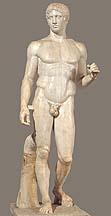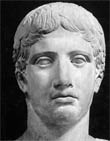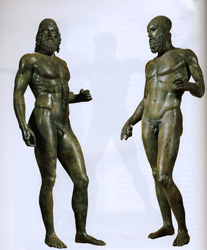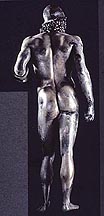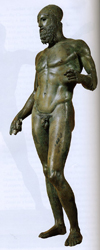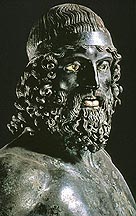ARTH Courses | ARTH 209 Home | ARTH 209 Assignments
Polyclitus's Canon and the Idea of Symmetria
Doryphoros of Polyclitus, Roman copy in marble of bronze original, c. 450-440 B.C.
The first datable professional treatise on sculpture was the Canon
of Polyclitus, probably written during the third quarter of the fifth century
B.C. The Canon was the most renowned ancient treatise on art, and enough
information is preserved about it in extant ancient texts to enable us to
form some conception of its content. The aim of the Canon, was not
simply to explain a statue but also to achieve to kallos, "the
beautiful” and to eu (the perfect or the good) in it. The secret
of achieving to kallos and to eu lay in the mastery of symmetria,
the perfect "commensurability" of all parts of the statue to one
another and to the whole.
In commenting upon the opinion of the Stoic philosopher Chrysippus that health in the body was the result of the harmony of its constituent elements, the physician Galen (second century A.D.) adds the following interesting sidelight:
| Beauty, Chrysippus feels, resides not in the commensurability (symmetria) of the constituents (i.e. of the body), but in the commensurability of parts, such as the finger to the finger, and of all the fingers to the metacarpus and the wrist (carpus), and of these to the forearm, and of the the forearm to the arm, in fact of everything to everything, as it is written in the Canon of Polyclitus. For having taught us in that treatise all the symmetriae of the body, Polyclitus supported his treatise with a work, having made a statue of a man according to the tenets of his treatise, and having called the statue itself, like the treatise, the Canon. |
Polyclitus's idea of symmetria and the pursuit of the to kallos and to eu was probably influenced by exposure to the ideas of Pythagoras of Samos ( active in the late sixth century B.C.) and of his followers. Pythagoreans were concerned with finding some underlying pattern in visual phenonmenon. Their fascination with number was directly connected to this belief that in number can be found the key to physical bodies but also of abstract qualities like justice. As a demonstration of this principle, they explored musical harmony and noted how the intervals needed to produced harmonic chords on the string of a lyre were expressible in a limited group of integers ( 2:1, 3:2, 4:3,etc.). This led Pythagoras to search for these patterns in other visual phenomenon like the movements of the planets and the relationships of the stars. He believed that these underlying harmonic proportions could be found throughout nature. These patterns demonstrated the Greek conception of nature as cosmos.
Pythagoreans
also saw reality as having a pattern of oppositions. Aristotle presents the
following list of these binaries:
|
Aristotle, Metaphysics, I.5.986a22: “Members of this school [the Pythagoreans] say there are ten principles, which they arrange into two columns of cognates, thus: limited
and unlimited |
Modern scholars have seen in Polyclitus's work a similar balance of opposites. Three of these pairs are easily detected in the Dorphoros: right/left, rest/movement, and straight/curved. Scholars have noted what they call the chiastic principle in the composition of the figure of the Doryphoros. The term is derived from the Greek letter chi which is formed by two lines crossing obliquely, but the stroke descending right to left is straight while the other is, like a reversed S, curved at both ends. Thus the upper curve on the left corresponds to a mirror-image curve on the lower right and two straight halves face each other across the sinuous divide. The following illustration imposes the letter chi onto the figure of the Doryphoros:
In the figure note how the two sides of the figure are opposed with the left side as the straight side (straight arm and leg) and the right side is the bent side (bent arm and leg). These oppositions are then balanced with the contrast between active and passive parts of the body: the leg to our left is active (engaged) and is echoed across the figure with the arm supporting the spear. The leg on our right is passive (free leg) and echoed by the left arm that is relaxed or passive. The balancing of the figure is further evident in the chest turned towards our right while the head turns towards our left. The lowered left shoulder is balanced by the lowered right hip while the raised right shoulder is balanced by the raised left hip. The work can thus be seen as a harmony of the opposites much like the cosmos was seen in Pythagorean thought.
Alkmaion of Kroton (c. 500-450) writes about health of the body:
| What preserves health is the equality (isonomia) of the powers -wet, dry, hot, cold, sweet, and so forth --whereas the domination (monarchia) of any one of them engenders disease; for the rule of a single contrary is destructive. The active cause of disease is excess of heat or cold, the occasion of it excess or insufficiency of nourishment, the seat of it blood, marrow, or the brain. Disease may also be engendered by external causes such as water, environment, exhaustion, torture, or the like. Health on the other hand is a proportionate (symmetron) mixture of opposites. |
Note how this idea is equally applicable to health, politics, and art.
For a 360 degree view of the Doryphoros.
Art Bulletin review of Polykleitos, the Doryphoros, and Tradition.
As evident from this type of analysis, the Doryphoros is a very intellectual work. Our appreciation of the work is also influenced by our knowing the work only through later copies. The original, like the other major works of the period, was bronze, but because of the intrinsic value of the bronze, the work was melted down long ago. The effect of the original Doryphoros is perhaps echoed in a pair of free-standing bronze figures discovered in 1972 off the coast of southern Italy near the town of Riace. These so-called Riace Warriors have been dated by scholars to about the time of the Doryphoros:
Head of Riace Warrior A
